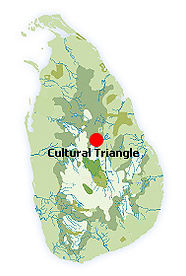POLONNARUWA
Kings ruled the central plains of Sri Lanka from Polonnaruwa 800 years ago, when it was a thriving commercial and religious centre. The glories of that age can be found in the archaeological treasures that still give a pretty good idea of how the city looked in its heyday. You'll find the archaeological park a delight to explore, with hundreds of ancient structures – tombs and temples, statues and stupas – in a compact core. The Quadrangle alone is worth the trip.
Thus, the Sacred Tooth Relic became the repository of Sinhala Sovereignty. The “Atadage” the Temple of the Tooth Relic is the most impressive structure among the remains of Polonnaruwa.The Gal Vihara, the Stone Reliquary, with its enormous rock sculptures is undoubtedly one of the greatest achievements of Sinhalese art.Polonnaruwa city is where you can see the island’s greatest historical treasures. It is still of great economic significance as a contributor to agriculture. The enormous reservoir called the Parakrama Samudraya (Sea of Parakrama) was built by King Parakramabahu the 1st (1153-1186 AD).The large expanse of water dominates the entire Citadel of Polonnaruwa and its environs with its retaining wall, 14 kms in length and 12m in height. The manmade reservoir covers a surface area of 15 sq.kms.
That Polonnaruwa is close to elephant-packed national parks only adds to its popularity. And with good accommodation and plenty of bikes for hire, the town itself makes a pleasant base for a day or two, fringed by a huge, beautiful tank with a relaxed ambience.

Polonnaruwa Information and Google Map
PROVINCE : NORTH CENTRAL PROVINCE
DISTRICT : POLOONARUWA DISTRICT
POPULAR : ANCIENT RUINS
WEATHER : 32 °C
PHOTO GALLERY
Cultural Triangle
The Cultural Triangle is found on Sri Lanka’s central plains and encompasses Anuradhapura, Polonnaruwa, Sigiriya, and Dambulla. It is here that the country’s kings gave rise to a great civilization based on agriculture and Buddhism. These kings also treasured the ancient healing wisdom of Ayurveda, which remains a preferred health care in rural areas. Anuradhapura, Sri Lanka’s first capital, was the greatest monastic city of the ancient world and was ruled from the 4C BC to 11C AD by more than 100 Sri Lankan kings. Polonnaruwa became Sri Lanka’s royal medieval capital in 1073 where the Sinhalese king Vijayabahu I followed by Parakramabahu I, ruled. It remained Sri Lanka’s capital until the late 13C. Another significant event in Sri Lanka’s history is the introduction of Buddhism to this island in 247 BC: Mihintale is especially inspiring on a full-moon day.
Food & Drink
Sri Lankan rice and curries and western cuisine is served in all the hotels within the Cultural Triangle. Heritance Kandalama is highly regarded for its award-winning cuisine ranging from lunch time buffets to fine dining. Vil Uyana’s Apsara restaurant with views of the Sigiriya rock, offers a la carte menu as well as a vegetarian menu. Mid-range hotels tend to rely largely on buffets; Chaaya Village’s wide choice and good quality gets excellent feedback. More details are in our hotel profiles. There are several wayside eateries and stalls on the way to the Cultural Triangle where a cup of tea or a Thambili (king coconut) – a great thirst quencher, or a cool drink can be purchased.
Shopping
The cultural triangle is not the area to plan a shopping expedition. Watermelon, pumpkin and other dry zone vegetables grown in village gardens as are found in wayside stalls. Groceries, pharmacies, and banks are available in the main towns. Buddha statues are available for purchase in Anuradhapura, Polonnaruwa and Dambulla.
Events
Vesak in Mihintale: takes place on full moon day in May with remembrance of Lord Buddha’s birth, enlightenment and Prinivanpama (his passing). In June, the festival of Poson is celebrated in remembrance of the introduction of Buddhism Sri Lanka by Mahinda.
Sights
Sri Lanka’s Cultural Triangle – as the name suggests – is home to a large proportion of historical cultural sites, including some of the island’s most famous and well-preserved ruins such as the medieval city of Polonnaruwa and the 5th century Sigiriya Rock Fortress. Read through our ‘Activities’ section to discover more about the ancient cultural sites in this region.







